Home > Nanotechnology Art Gallery > John Burch
John Burch
Click image to enlarge. All images © respective artist or company.
See Lizard Fire Studios - a 3D Animation and NanoTechnology Design Firm.
The images below are part of a presentation by the Foresight Nanotech Institute. They are intended to illustrate "an animated view of a nanofactory and
demonstrate key steps in a process that converts simple molecules into a billion-CPU laptop computer."
View the film "Productive Nanosystems: From Molecules to Superproducts," a four-minute computer-generated animated short film (Quicktime), or on streaming video. For lower bandwith readers, see the slide show version.
This film is a collaborative project of animator and engineer, John Burch, and pioneer nanotechnologist, Dr. K. Eric Drexler.
Chris Phoenix of CRN had this to say "... an almost-finished animation that illustrates how a nanofactory would actually work. This should lay to rest any remaining misunderstandings about "fingers" that "grab" atoms. The animation shows pointy molecules being pushed together and trading atoms between them--nothing new in that, except that the molecules are mounted on molecule-sized conveyor belts (also made out of molecules, of course). This is what Drexler has been saying for a decade, but now it's in a form that will make it hard for even the most wilfully dense skeptics to find something to misinterpret."
For more information on nanofactories, see Nanofactory Proposal Published and Bootstrapping a Nanofactory: From Fabricator to Finished Products and Pathway to Diamond-Based Molecular Manufacturing.
Be sure to visit's John's Blog Nano & Nature and his gift shop.
"Desktop Factory"
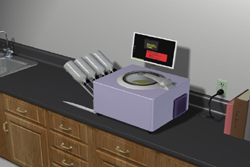
The Desktop Factory showing feedstock on the left and the product exit door on top.
|
"Inside the Box"
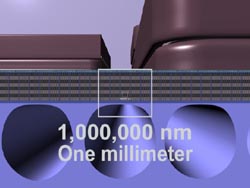
Edge view of the active exturder surface. Fuel stock pipes at the bottom deliver Acetylene and other chemicals. The layers in the center are the active nanomachines that tear apart chemicals and reassemble them into the products seen at the top of the picture. Products slowly extrude upward out of the layer.
|
"Molecular Mill 1"
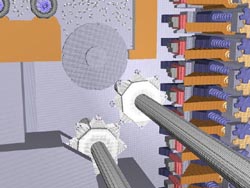
View of the smallest stage of the nanofactory. Wheels in upper left purify Acetylene molecules. The gray wheel at upper center presents individual molecules to the bonding tools on the white wheel at center. Hydrogen is stripped from the carbons by the white wheel at lower left, leaving only two carbon molecules. These two atoms are applied to the moving chain mechanism on the right to build small cubes of diamond.
|
"Molecular Mill 3"
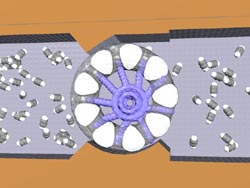
Close view of the purification wheels. The offset blue spider allows molecules to fill temporary holes on the left, inlet side and expels the molecules on the right output side of the wheel.
|
"Assembly of small into big"
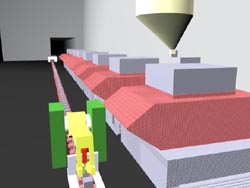
Small cubes of diamond coming in on belts at lower left, are assembled into large cubes of diamond on the right. Only one stage is shown.
|
"Extruder Stage 1"
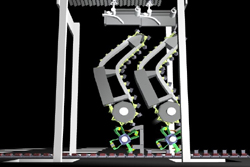
Side view of exturder stage of desktop factory. Fixed machines at the bottom supply new material to the moving mechanism at the top of the cantilever beams where diamond blocks are applied to the surface of a product under construction.
|
"Extruder Stage 2"
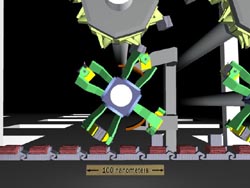
The pick up wheel removes blocks from a belt and hands them to a vertical chain mechanism in the extruder stage
|
"Three Attributes of Product"
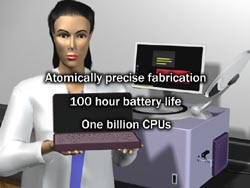
Final Result of the fabrication is shown by operator after removing the folded up computer from the nanofactory. Upon removal, the folded product self assmbles by unfolding and bonding active surfaces to assume final configuration.
|
"PuffBot"
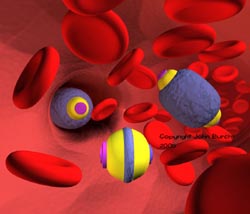
It shuts off the blood supply inside a cancer tumor. Requires very little intelligence since a doctor signals it to inflate once it enters the tumor. It is the same size as a red blood cell so it circulates over and over through the body until it does pass through the tumor. A few thousand could really cripple a tumor.
|
"Cancer Killer"
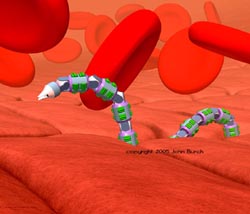
It is rather large and probably travels around by means of the blood supply. Once it is carried into a known tumor, it would begin killing cancer cells by rupturing their cell walls. It also allows a doctor to monitor blood chemicals and general health of the patient.
|









